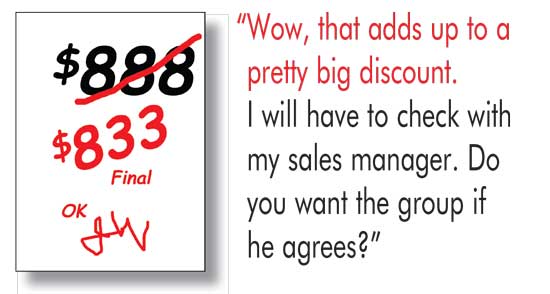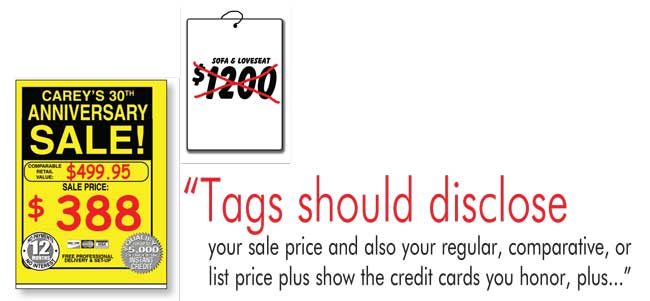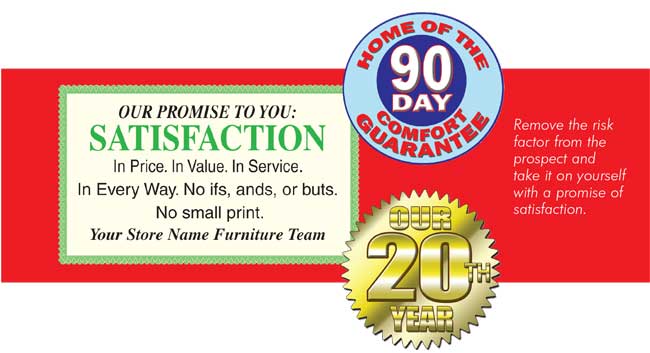It is quite possible that in 2016 one of your competitors, even a big box competitor, may develop a deceptive pricing scheme or, more likely, bring in a hired gun to implement one for them. The tactics are effective, having been developed for stores going out of business. And, the techniques used are very effective at making customers believe that they will get great bargains, when in truth they may be getting very little off regular prices.
I should state now that there are legitimate high impact furniture promoters out there who bring in a crew to take over a troubled store. They can be helpful if an authentic liquidation or promotion is called for, if a furniture merchant needs more inventory, additional management expertise or lacks skillful, trained sales consultants. But there are also a few companies who promote in a way that only give the impression a store is going out of business. The intention is to create a buying frenzy, raise cash, and then get out of town.
Competing furniture retailers often suffer a nosedive in morale and sales volume when promotion companies come to town to run what’s often called a high impact sale. If you find yourself in this situation, what can you do to compete? This is the principle issue this article will address.
Establishing The Illusion of Value
My principle objective here is to provide you the very best legitimate tactics to effectively compete.
As I have stated, these tactics are highly effective. And they capitalize upon the fact that few shoppers are willing to consciously pay regular retail prices for home furnishings these days. I repeat: Few shoppers are willing to consciously pay regular retail prices for home furnishings these days. The operative word here is consciously. Everyone wants a “deal,” especially during times of economic stress.

Most furniture sales consultants are not accustomed to negotiating prices. So, they are highly vulnerable when a competitor brings in a sales manager and sales people who are trained as “black belts” in negotiating prices. Their mantra is: “Name your own price, folks, no reasonable offer will be refused.”
In a situation like this, your regular sales staff is usually at a disadvantage. You may think at this point that the regular sales manager and sales staff would object to bringing in a team of strangers. The truth is they do object. But they also need their jobs. A few may leave, but most will simply cope, knowing the demoralizing situation will be temporary. However, the long term impact on the store’s credibility can be severe.
The next step in negotiating an illusionary bargain price is to remove all the original price tags and replace them with new tags. Nothing wrong with this, it’s a sale. Legitimate promoters replace the old tags with new sale tags that show a valid regular price (or reasonable comparable value or list price) and a new sale price. However, the new tag replacements at our fictional store are very different. They have one price. The price they show is inflated. That fictitious price is crossed out with a stroke of bright red ink. There is no other price on the tag. So, how much does the item really cost? That’s where the phony negotiating comes in.
Here is how the sales sequence might unfold. Our imaginary sales person spots a couple looking at a sofa and loveseat.
Sales Person: “Hello folks. My name is Joe and I am authorized to offer you a big discount on the price of this group. The listed price is $1200, but I can offer it at our liquidation price of only $888. How does that sound?” [Sales person writes the new price of $888 in black ink on a small pad and shows it to the couple. [NOTE: The everyday sale price of this item is in truth $795.]
Prospects: “$888 is a lot better. But we hadn’t really planned to spend that much.”
Sales Person: “I sure would like to see you get this group, folks. What price would it take to get you to make the purchase today? I am authorized to accept any reasonable offer. No rush, if you want to discuss it, I will walk away so you can have some privacy. ”
Prospects: [After brief discussion] “Will you take another $50 off?”
Sales Person: “Wow, that adds up to a pretty big discount. I will have to check with my sales manager. Do you want the group if he agrees?” [This is known as a sharp-angle close.]
Prospects: “Well … yes, we guess so.” [Sales person leaves briefly. He returns all smiles.]
Sales Person: “Great news, folks! He agrees to accept your offer!” [The sales person shows the pad upon which he wrote the $888 price with black ink. That price has been marked out with a bright red marking pen and a new price of $833 is written in red, plus a big “OK” and the initials of the Sales Manager.]
Sales Person: “Congratulations folks! You just saved yourself $367! You are sure good negotiators!”
The sad truth is these prospects could have bought the same sofa and loveseat at the regular sale price of $795 and saved another $38.
How can a legitimate home furnishings entrepreneur compete with such tactics?
Great Stores Don’t Panic. They Educate.
The prospects in the example above have no idea that they were duped. Eventually, however, they may learn the real value of their purchase. Will they want to return to that store for future shopping? Not likely. The damage done to the credibility and integrity of the store after the sale is over incalculable. Nothing is more precious than a store’s reputation for integrity and a sense of fairness. Once shoppers are educated about how the phony negotiation works, they will never let it happen again. It is the job of a legitimate retailer, you, to provide the education prospective customers need in two ways:
- How to spot a deceptive pricing tactic.
- How to appreciate the “Added Value” of your products, beyond their retail price.

Spotting Deceptive Pricing
First of all, write this in stone: Deceptive pricing tactics work because everyone wants a “deal,” especially during times of economic stress. Your best protection against deception is truth. For this reason I recommend “Advertorial” ads that reveal a competitor’s deceptive liquidation tactics and also tell your added value story. “Advertorial” ads look like news stories, though they are plainly labeled as advertisements. If the copy is done in an informative and credible way, research shows the public appreciates the information it provides. Small space ads can also be used to provide a “heads up” caution to the general public when unscrupulous tactics are being employed. Make sure your sales staff reads this article so they can deliver a credible follow up to your campaign.
Get Credit For The Values You Offer
To the general public, furniture and mattress sets are a “sack of sand.” The reason the illusionary process works is that prospects usually have no idea what the product they are looking at is really worth. Many cheap “look-alikes” pass for the real thing. So the price on the large fake price tag is rarely challenged.
A legitimate sale price tag should plainly disclose two prices. One price is the sale price, of course. The other price is either “our regular low price,” a reasonable “comparative value,” or an authentic “list price.” This educates prospects along reasonably trustworthy lines and enables them to make an informed decision.
Unfortunately, in their sincere desire to establish price integrity, some legitimate merchants stick to a single price system. When they have a storewide sale, they use a tag with one price, the sale price. Thus, even when the item has been substantially reduced these merchants do not get credit for the values they are offering. There is only one price featured in their print advertising, on their website, and their point of purchase price tags. Thus, these entrepreneurs don’t get acknowledgment for the actual value of their products. So, even though a “one price” store has a good selection and a service-minded staff that could help prospects find perfect solutions to their home furnishings needs, they lose many of the sales they deserve.
Message your “Added Value” Features. Consultant Bill Napier agrees that no one consciously pays full price anymore, but he points out that this does not mean you have to join the “race to the bottom” and lower your prices. You can still receive value-added profits for your products and services. Napier discloses a few retailers who have succeeded in doing this. Best Buy, for example, changed their messaging to adapt to today’s consumer as follows:
“BUY WITH CONFIDENCE”
Expert Service – Unbeatable Prices
We make it easy to make your
purchase with expert advice,
our price match guarantee,
free shipping on orders $35
and up, trade-in and much more.
Also consider the tactics of Sheely’s Furniture and Appliances, who have made an investment to educate, inspire and motivate consumers to do business with them. Napier discloses that Google’s new research tells them that 83% of moms search the internet for answers to their questions. They simply do not have time to scour fashion magazines for the latest trends in home furnishings fashions. Is your website a rich resource for them?

Or consider Sherman’s Furniture and Appliance who state clearly on their website video: “If you don’t like it, bring it back in 30 days, no questions asked.”
Now, how can you develop a compelling appeal that can boost you to new levels of performance?
Beyond Price–The Magic Of Added Value
Jay Abraham tells an unforgettable allegory about the power of added value. I told this story to Furniture World readers several years ago, but it is worth retelling. “Make ‘em an offer they can’t refuse” says Jay. To do this successfully, you must educate your sales consultants so they are able to educate your prospects about your company’s added value features. Jay illustrates this principle with a story of a farmer who wants to buy a pony for his young daughter. The farmer is considering two offers. In each case the ponies are equal in merit. One of the pony owners tell the farmer that the deal is $500 for the pony, take it or leave it.
But the second owner has a different deal. It is an “added value” offer that was more expensive, $750. Yet it was “an offer the prospect can’t refuse.” He told the farmer that, before he made a buying decision, he wanted his daughter to try out his pony for a month. He offered to deliver the pony to the farmer’s home along with a month’s supply of hay to feed the pony. He will send out his own stableman once a week to show his daughter how to groom and care for the pony. He suggested that, although the pony was kind and gentle it would be wise if the farmer had his daughter ride the pony each day to make sure they got along. Finally, he said he would drive out to the farmer’s house after a month and either take back the pony and clean up the stall–or pick up his $750. Of course, the farmer took the second, but much more value-rich deal. A no-brainer, right?

Now, consider what would have happened if the second pony owner had not educated the farmer by disclosing all the added value in his offer.
Now contemplate your own promotional efforts. Are you telling your added-value story in all phases of your media?
1. Beginning with your point of purchase tags, are you getting credit for your added value features? These tags should disclose your sale price and also your regular, comparative, or list price plus show the credit cards you honor, plus “Free professional local delivery and set-up, etc.
2. Does your advertising, including print media, including direct mail, and air media, tell your added value story in a compelling way?
3. Are you removing the risk factor from the prospect and taking it on yourself with a promise of satisfaction?
4. Removal of an old mattress is not unusual, but the removal and donation of old furniture is welcomed, especially by seniors.
5. Are your sales consultants telling your story with clarity and passion so prospects know why you deserve their business?
6. Is your website up to date and informative? Are you on Facebook, and do you update your presence often with news and information?
7. Are you making a personal follow up call [or at least delegating this task to a manager] to customers who have made a recent purchase? Are you asking them for a referral? [See: “Retail Enterprise Thinking” www.furninfo.com/Furniture%20World%20Articles/3574
8. Does every prospect who leaves your store carry a promotion piece, a silent sales person, that tells your story in a compelling way?
These are a few of the essential added value possibilities for a retail furniture store. Brainstorm with your staff and also garner ideas from books and articles. I suggest you get a copy of Jay’s original book: Getting Everything You Can Out of All You’ve Got … 21 Ways You Can Out-Think, Out-Perform, and Out-Earn the Competition. This book is my personal favorite by Jay. In it he gives practical, useful advice for leveraging your current assets toward maximum productivity. The promo stated: “You can consult marketing genius Jay Abraham for $5000 an hour–or get his best ideas in this book for under $25.” Actually, you can download a copy of the first chapter of the book in .pdf format for free.
Finally, if unscrupulous competition has you down, here is advice from the classic book, “The Once and Future King” by T. H. White:
“The best thing for being sad,” replied Merlin, beginning to puff and blow, “is to learn something. That’s the only thing that never fails. You may grow old and trembling in your anatomies, you may lie awake at night listening to the disorder of your veins, you may miss your only love, you may see the world about you devastated by evil lunatics, or know your honor trampled in the sewers of baser minds. There is only one thing for it then — to learn. Learn why the world wags and what wags it. That is the only thing which the mind can never exhaust, never alienate, never be tortured by, never fear or distrust, and never dream of regretting. Learning is the only thing for you. Look what a lot of things there are to learn.”
Larry Mullins is a contributing editor for Furniture World and has 30+ years of experience on the front lines of furniture marketing. Larry’s mainstream executive experience, his creative work with promotion specialists, and mastery of advertising principles have established him as one of the foremost experts in furniture marketing. His affordable High-Impact programs produce legendary results for everything from cash raising events to profitable exit strategies. His newest books, THE METAVALUES BREAKTHROUGH and IMMATURE PEOPLE WITH POWER… How to Handle Them have recently been released by Morgan James Publishing. Joe Girard, “The World’s Greatest Salesman” said of this book: “If I had read Larry Mullins’ book when I started out, I would have reached the top much sooner than I did.” Larry is founder and CEO of UltraSales, Inc. and can be reached directly at 904.794.9212 or at Larrym@furninfo.com. See more articles by Larry at www.furninfo.com or www.ultrasales.com.